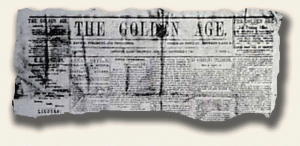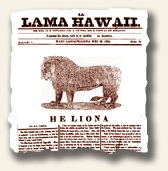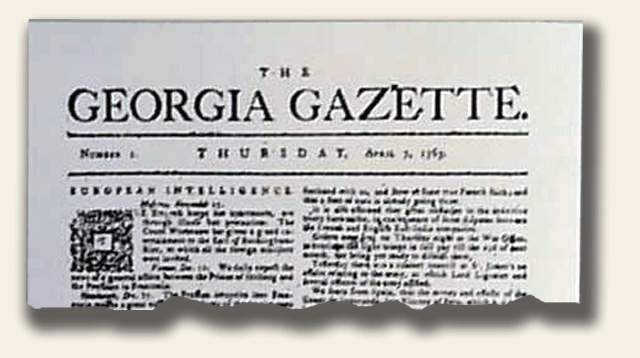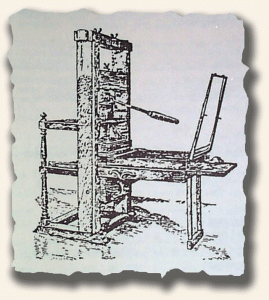First newspaper in Idaho…
March 1, 2010 by TimHughes · Leave a Comment
Idaho’s name was adapted from the Shoshone Indian call, “Ee-dah-how!”. Its literal translation is “Look! The sun is coming down the mountain.” It was a part of the “Oregon Country” claimed by Spain until 1819 and by Russia until 1824. Great Britain and the United States held it jointly until Britain relinquished her claim to the United States by treaty in 1846.
 In 1839 the American Board of Foreign Missions brought back from Hawaii the printing outfit that had been sent there in 1821 (see our post for Feb. 22: “Hawaii’s first newspapers…”) and transferred it to Idaho. In 1862 in Lewiston, named after explorer Meriwether Lewis, Idaho’s first newspaper, the “Golden Age”, was established by A. S. Gould who hasd previous printing exerience in California and Oregon. The “Golden Age” was discontinued in 1865 when the printing press was moved to Leesburg. In 1867 the “Mining News” was established but the printer was able to keep it going for only eight months.
In 1839 the American Board of Foreign Missions brought back from Hawaii the printing outfit that had been sent there in 1821 (see our post for Feb. 22: “Hawaii’s first newspapers…”) and transferred it to Idaho. In 1862 in Lewiston, named after explorer Meriwether Lewis, Idaho’s first newspaper, the “Golden Age”, was established by A. S. Gould who hasd previous printing exerience in California and Oregon. The “Golden Age” was discontinued in 1865 when the printing press was moved to Leesburg. In 1867 the “Mining News” was established but the printer was able to keep it going for only eight months.
The first newspaper in southern Idaho (3nd in the territory), the “Boise News” was started on Sept. 29, 1863 at Idaho City, and the fourth newspaper, the “Idaho Tri-Weekly Statesman” began printing on July 26, 1864 in Boise.
First newspapers in Hawaii…
February 22, 2010 by TimHughes · Leave a Comment
The American Board of Foreign Missions sent a printing press to Hawaii in 1820, but it wasn’t until fourteen years later that a periodical was printed in the islands.  Hawaii’s first newspaper was done by students of a missionary seminary on the island of Maui on Feb. 14, 1834, titled: “Ka Lama Hawaii” (Hawaiian Luminary). A similar paper titled “Ke Kumu Hawaii” appeared in Honolulu in October of the same year. Both were printed in the Hawaiian language.
Hawaii’s first newspaper was done by students of a missionary seminary on the island of Maui on Feb. 14, 1834, titled: “Ka Lama Hawaii” (Hawaiian Luminary). A similar paper titled “Ke Kumu Hawaii” appeared in Honolulu in October of the same year. Both were printed in the Hawaiian language.
In 1836, two years after Hawaiian language newspapers took hold, the first English language paper was born, the “Sandwich Island Gazette and Journal of Commerce“. This newspaper was only printed sporadically and lasted for just three years. It wasn’t until 1856 that the first regular English language paper was established, the weekly “Pacific Commercial Advertiser“. The “Advertiser” has published continuously since then, switching names to today’s Honolulu Advertiser in 1921.
First newspapers in Georgia…
February 15, 2010 by TimHughes · 2 Comments
 Georgia, founded in 1733, was named after King George II of Great Britain. James Johnston, a Scotsman, was the colony’s first printer. He established the “Georgia Gazette“at Savannah on April 7, 1763. The “Gazette” was issued with intermissions and changes of name for nearly forty years. During one of the intermissions Johnston published the “Royal Georgia Gazette“, which he purchased from John Hammerer who had started it on January 21, 1779.
Georgia, founded in 1733, was named after King George II of Great Britain. James Johnston, a Scotsman, was the colony’s first printer. He established the “Georgia Gazette“at Savannah on April 7, 1763. The “Gazette” was issued with intermissions and changes of name for nearly forty years. During one of the intermissions Johnston published the “Royal Georgia Gazette“, which he purchased from John Hammerer who had started it on January 21, 1779.
John E. Smith started the “Georgia State Gazette or Independent Register” at Augusta on Sept. 30, 1786. In 1789 it became the “Augusta Chronicle and Gazette of the State” and later was shorted to just the “Augusta Chronicle“.
Celebrating 150 years since Arizona’s first newspaper…
November 2, 2009 by TimHughes · 2 Comments
The history of Arizona, an Indian word meaning “place of small springs”, goes back some 10,000 years B.C. with the arrival of the first Native Americans, while its history as recorded by Europeans dates to 1539 when the first white an, Marcus de Niza, a Franciscan friar arrived. It was organized as a territory in 1863 and admitted as a state in 1912, the last of the 49 contiguous states to join the Union.
Arizona’s first newspaper was the “Arizonian”, started at Tubac in March, 1859. Tubac lies about midway between Tucson and the Mexican border. For the following we credit Megan Thomas and the Chronkite News Service:
“For visitors at Tubac Presidio State Historic Park, (volunteer James) Pagels rolls ink and presses paper to metal to demonstrate a Washington Hand Press that was used to print the state’s first newspaper, “The Weekly Arizonian”. It still provides visitors with replicas of the paper.
“It’s living history,” Pagels said.
Arizona State Parks is preparing to celebrate the 150th anniversary of the arrival of the press in Arizona. Brought by ox cart from the Mexican port of Guaymas for William Wrightson of the Santa Rita Mining Co., the press turned out the first copy of the Arizonian on March 3, 1859, promoting the mining company and its agenda.
The “Arizonian” published out of Tubac for several months before moving to Tucson. According to an account by the late Douglas C. McMurtrie, a historian of printing in the U.S., the newspaper apparently ceased publication in the summer of 1860, resumed briefly in 1861 and resumed once again in 1867 – both times under different ownership – before finally folding for good in 1871. The press wound up in Tombstone, printing the Nugget newspaper for a time, and, according to McMurtrie, passed to the Arizona Historical Society in 1913.
Back home in Tubac and on permanent loan to Arizona State Parks, the press is a point of pride, said Joe Martinez, manager of the park.
“I think it’s amazing that the press came here in 1859 can still function today and we can show it to people and give them copies of the first edition,” Martinez said.
That edition describes attacks by Native Americans and crimes including horse thefts. It notes that stagecoaches were charging 40 cents to $1 per pound for extra baggage on runs between El Paso and San Diego. A section is devoted to the obituary of James Gadsden, who brokered the purchase from Mexico of nearly 30,000 square miles that are now part of southern Arizona and New Mexico.”
More on printing newspapers in the 1700’s…
August 24, 2009 by TimHughes · 3 Comments
This article is primarily taken from the April, 1996 edition of “Collectible Newspapers” edited by Rick Brown, whom we thank for this contribution. It offers some interesting insights into the printing & distributing of newspapers in the colonial and post-colonial era of the United States.
 Newspapers from the latter half of the 18th century were relatively scarce. One factor was that early settlers were busy clearing the land & otherwise making the land habitable & sustaining. Plus only a small percentage of the population had reading skills beyond that of the basic rudiments. Although most towns of any size by 1715 had tracts of land set aside for schools, few actually had schools built & in operation.
Newspapers from the latter half of the 18th century were relatively scarce. One factor was that early settlers were busy clearing the land & otherwise making the land habitable & sustaining. Plus only a small percentage of the population had reading skills beyond that of the basic rudiments. Although most towns of any size by 1715 had tracts of land set aside for schools, few actually had schools built & in operation.
Nearly all 18th century newspapers were edited & published by printers that had a general printing business and also printed pamphlets, books, broadsides, lottery tickets, etc. Many also sold merchandise, groceries, patent medicines, and a variety of other goods. Rags, which were used to make the paper , were scarce in the colonies so most of the paper was imported from England.
Newspapers were printed on wooden hand presses with each applicatoin of ink to paper requiring a pull of by lever and screw. It was not until around 1816 that the new iron Columbian press came into general use. Instead of a screw it used a series of compound levers that multiplied the pull of the operator. But still, all hand presses were slow & laborious. The forms had to be laid by hand and the ink was poor and of uneven quality. Types were frequently old and worn.
After the newspapers were printed, distribution difficulties were encountered. Circulation was confined, for the most part, to the towns in which they were published. They were distributed to the rural areas by postboys on horseback and by stagecoach drivers. The roads were bad & the postal system was slow. Subscribers were few & the cost of an issue relatively expensive so newspapers were typically handed around from one to another so that a single copy was ready by many. Even those who subscribed often failed to pay for their subscriptions.
It has been estimated that the largest circulation of a single newspaper during the earlier colonial period was about 350 and that only a few reached this high of a number of circulation. By the 1750’s circulation for larger city newspapers reached upwards of 600 of each issue printed and during the Revolutionary War some newspapers boasted circulations in excess of 2000. By 1790 most newspapers were printing less than 1000 copies but the very popular “Columbian Centinel” from Boston was printing over 4000 copies of each printing date.
Despite poor equipment, limited circulation, nonpaying subscribers, poor distribution facilities & the general unprofitability of publishing a newspaper, the number of newspapers being published continued to increase as the years went by. There were numerous failures, but new newspapers were established to replace them. From 1704 to 1820 about 1634 newspapers came to life and died. Of that number only two-thirds of them lived beyond three years.


